Papers by Roderik Lindenbergh

ISPRS Annals of the Photogrammetry, Remote Sensing and Spatial Information Sciences, Aug 19, 2015
Laser scanning has become a well established surveying solution for obtaining 3D geo-spatial info... more Laser scanning has become a well established surveying solution for obtaining 3D geo-spatial information on objects and environment. Nowadays scanners acquire up to millions of points per second which makes point cloud huge. Laser scanning is widely applied from airborne, carborne and stable platforms, resulting in point clouds obtained at different attitudes and with different extents. Working with such different large point clouds makes the determination of their overlapping area necessary but often time consuming. In this paper, a scalable point cloud intersection determination method is presented based on voxels. The method takes two overlapping point clouds as input. It consecutively resamples the input point clouds according to a preset voxel cell size. For all non-empty cells the center of gravity of the points in contains is computed. Consecutively for those centers it is checked if they are in a voxel cell of the other point cloud. The same process is repeated after interchanging the role of the two point clouds. The quality of the results is evaluated by the distance to the pints from the other data set. Also computation time and quality of the results are compared for different voxel cell sizes. The results are demonstrated on determining he intersection between an airborne and carborne laser point clouds and show that the proposed method takes 0.10%, 0.15%, 1.26% and 14.35% of computation time compared the the classic method when using cell sizes of of 10, 8, 5 and 3 meters respectively.
Iet Science Measurement & Technology, Mar 1, 2018
Intercomparison among six terrestrial laser scanner systems focused on the measurement of small e... more Intercomparison among six terrestrial laser scanner systems focused on the measurement of small elements (< 0.5 m) is performed. Two standard artifacts containing 3D printing spheres and steps of variable height are used for the experiment. Results show errors between-4.5 mm and 3.5 mm in the measurement of distance between sphere centers and errors ranging from-1 mm to 8 mm in the measurement of distances between step planes. The most stable systems for measuring small elements seem the Leica C10, Faro Photon and Riegl LMS Z390i.
International journal of applied earth observation and geoinformation, Jul 1, 2022

ISPRS Annals of the Photogrammetry, Remote Sensing and Spatial Information Sciences, Jul 17, 2012
The Tibetan plateau is covered by hundreds of larger and smaller lakes. Until recently there was ... more The Tibetan plateau is covered by hundreds of larger and smaller lakes. Until recently there was no method to monitor their water level variations due to lack of in-situ measurements or unfitness of available remote sensing methods. However the ICESat/GLA14 laser altimetry data provide global surface elevations for land during 18 one-month campaigns between 2003 and 2009. This product could be used to accurately monitor water level variations and to estimate annual water level trends of about 150 Tibetan lakes. Based on the ICESat campaign schedule, lake levels derived from the GLA14 data are classified into three groups referenced to the Tibetan seasons: late dry, early wet, and early dry. For each lake sampled by sufficient ICESat campaigns, seasonal water level trends could be estimated and inter-seasonal lake level variations could be determined. The results indicate that most of the southern Tibetan lakes have a downward seasonal trend while most lakes elsewhere in Tibet have a positive seasonal trend. This means that these seasonal trends are similar to the annual trends. Moreover, lake level variations between seasons are much larger in the south than in the north and the west of Tibet. Based on the spatial pattern of the lakes, the Tibetan plateau is divided into four sub-areas corresponding to seasonal lake level trends and inter-seasonal lake level variations. The results confirm climatic trends as discussed in meteorological literature. Therefore, this analysis is expected to improve the understanding of the limnological processes on the Tibetan plateau and their impacts on the surrounding regions.

The International Archives of the Photogrammetry, Remote Sensing and Spatial Information Sciences, Jun 5, 2019
Sandy beaches are highly dynamic areas affected by different natural and anthropogenic effects. L... more Sandy beaches are highly dynamic areas affected by different natural and anthropogenic effects. Large changes, caused by a storm for example, are in general well-understood and easy to measure. Most times, only small changes, at the centimeter scale, are occurring, but these changes accumulate significantly over periods from weeks to months. Laser scanning is a suitable technique to measure such small signals, as it is able to obtain dense 3D terrain data at centimeter level in a time span of minutes. In this work we consider two repeated laser scan data sets of two different beaches in The Netherlands. The first data set is from around the year 2000 and consists of six consecutive yearly airborne laser scan data sets of a beach on Texel. The second data set is from 2017 and consists of 30 consecutive daily terrestial scans of a beach near The Hague. So far, little work has been done on time series analysis of repeated scan data. To obtain a first grouping of morphologic processes, we propose to use a simple un-supervised clustering approach, k-means clustering, on de-leveled, cumulative point-wise time series. The results for both regions of interest, obtained using k=5 and k=10 clusters, indicate that such clustering gives a meaningful decomposition of the morphological laser scan data into clusters that exhibit similar change patterns. At the same time, we realize that the chosen approach is just a first step in a wide open topic of clustering spatially correlated long time series of morphological laser scan data as are now obtained by permanent laser scanning.
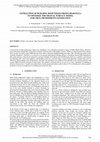
The International Archives of the Photogrammetry, Remote Sensing and Spatial Information Sciences, May 30, 2018
Various kinds of urban applications require true orthophotos. True orthophoto generation requires... more Various kinds of urban applications require true orthophotos. True orthophoto generation requires a DSM (Digital Surface Model) to project the photo orthogonally and minimize geometric distortion due to topographic variance. DSMs are often generated from airborne laser scan data. In urban scenes, DSM data may fail to deliver sharp and straight building roof edges. This will affect the quality of the resulting orthophotos. Therefore, it is necessary to incorporate good quality building outlines as breaklines during DSM interpolation. This study proposes a data-driven approach to construct building roof outlines from LiDAR point clouds by a workflow consisting of the following steps: given roof segments, roof boundary points are extracted using a concave hull algorithm. Straight edges may be difficult to find in complex roof configurations. Therefore, two ingredients are combined. First, RanSAC corner point preselection, and second, DBSCAN-based clustering of edge points. The method is demonstrated on an area of ±1.2 km 2 containing 42 buildings of different characteristics. A quality assessment shows that the proposed method is able to deliver 92% of building lines with acceptable geometric accuracy in comparison to a building line in the base map.

The International Archives of the Photogrammetry, Remote Sensing and Spatial Information Sciences, May 30, 2018
Build on soft soil, close to sea level the Netherlands is at high risk for the effects of subside... more Build on soft soil, close to sea level the Netherlands is at high risk for the effects of subsidence and deformation. Interferometric Synthetic Aperture Radar (InSAR) is successfully used to monitor the deformation trends at millimetre level. Unfortunately the InSAR deformation trends suffer from poor geolocation estimates, limiting the ability to link deformation behaviour to objects, such as buildings, streets or bridges. A nationwide, high resolution, airborne LiDAR point cloud is available in the Netherlands. Although the position accuracy of this LiDAR point cloud is to low for deformation estimates, linking the InSAR location to the geometries outlined by the LiDAR point can improve the geolocation estimates of the InSAR trends. To our knowledge no such integration is available as of yet. In this article we outline methods to link deformation estimates to the LiDAR point cloud and give an outlook of possible improvements. As a test we link 3.1 million TerraSAR-X InSAR Persistent Scatterers to 3 billion LiDAR points, covering the city of Delft and surroundings.
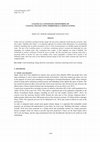
Sandy coasts are vulnerable to predicted climate change, but also need to safeguard coastal housi... more Sandy coasts are vulnerable to predicted climate change, but also need to safeguard coastal housing, recreation, safety and ecology. "Building with Nature" is an important approach for resilient coastal maintenance, but corresponding predictive modelling tools are partly inconclusive, due to a lack of measurements over multiple spatial and temporal scales. The aim of the CoastScan project is to develop a monitoring system to measure and understand dry coast topography over multiple scales with a permanent laser scanner. A field campaign was setup at Kijkduin, The Netherlands to monitor a kilometre of beach for up to 6 months. The first permanent laser scanning results show a promising ability to monitor the coast over multiple scales: hourly topography is obtained with a quality at the millimetre range, while time series at four different locations lasting 10 days show subtle variations that could not be compared before.

Coastal Engineering Proceedings
A beach in Mariakerke-Bad (Belgium) was monitored in 2017-2018 for more than a year with a near-c... more A beach in Mariakerke-Bad (Belgium) was monitored in 2017-2018 for more than a year with a near-continuous laser scan system. From a total of 8500 scans 7700 hourly scan epochs were used to study the spatio-temporal shoreward sand transport at the beach. In order to account for weather influences and other possible disturbances of the scan-system, a time-dependent correction method was applied to reduce rotation errors up to 0.2 degrees in the point cloud orientation (around the zero point of the laser scanner) reducing height errors on the beach to the order of centimeters. Cross shore analysis of the beach profile shows that shoreward transport occurs at most times during the year with an accumulated maximum of 17m3/m throughout the measurement period and maximum transport rates of 0.6 m3/m/day. However most of the shoreward sand transport is redistributed seawards again due to beach shaping leaving a total of about 2 m3/m a year which is below the average values found along the B...

The International Archives of the Photogrammetry, Remote Sensing and Spatial Information Sciences
The advancement of permanently measuring laser scanners has opened up a wide range of new applica... more The advancement of permanently measuring laser scanners has opened up a wide range of new applications, but also led to the need for more advanced approaches on error quantification and correction. Time-dependent and systematic error influences may only become visible in data of quasi-permanent measurements. During a scan experiment in February/March 2020 point clouds were acquired every thirty minutes with a Riegl VZ-2000 laser scanner, and various other sensors (inclination sensors, weather station and GNSS sensors) were used to survey the environment of the laser scanner and the study site. Using this measurement configuration, our aim is to identify apparent displacements in multi-temporal scans due to systematic error influences and to investigate data quality for assessment of geomorphic changes in coastal regions. We analyse scan data collected around two storm events around 09/02/2020 (Ciara) and around 22/02/2020 (Yulia) and derive the impact of heavy storms on the point cloud data through comparison with the collected auxiliary data. To investigate the systematic residuals on data acquired by permanent laser scanning, we extracted several stable flat surfaces from the point cloud data. From a plane fitted through the respective surfaces of each scan, we estimated the mean displacement of each plane with the respective root mean square errors. Inclination sensors, internal and external, recorded pitch and roll values during each scan. We derived a mean inclination per scan (in pitch and roll) and the standard deviation from the mean as a measure of the stability of the laser scanner during each scan. Evaluation of the data recorded by a weather station together with knowledge of the movement behaviour, allows to derive possible causes of displacements and/or noise and correction models. The results are compared to independent measurements from GNSS sensors for validation. For wind speeds of 10 m/s and higher, movements of the scanner considerably increase the noise level in the point cloud data.
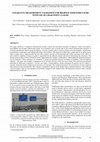
The International Archives of the Photogrammetry, Remote Sensing and Spatial Information Sciences
This paper introduces a method to automatically estimate vertical and horizontal clearances of hi... more This paper introduces a method to automatically estimate vertical and horizontal clearances of highway viaducts and gantries from Mobile Laser Scanner (MLS) point clouds. It is essential to have accurate data on the vertical and horizontal clearances of overhead infrastructure objects along the highway. Accurate clearance data is used for routing oversized transports, infrastructure reconstruction, maintenance and settling legal claims after incidents. The proposed method takes a point cloud of an infrastructure object as input, and as output provides the user with a concise overview of the horizontal and vertical clearances of the object. A point cloud of a highway overpass or gantry is segmented into the different clusters relevant for determining the clearances. The discrete points in these clusters will then be used to approximate their surfaces with B-splines. Subsequently the minimal clearances can be estimated. These clearances are estimated at certain pre-specified locations according to guidelines from the highway authority. The paper also includes a comparison of the inferred clearances from the point clouds with archived measurements performed by third party contractors. For this case study, a Dutch highway section containing 50 gantries and 20 viaducts is selected. Along this stretch of highway the clearances are estimated. The estimated clearances for each structure are then compared with archived in situ measurements. This will give a quantitative analysis of the quality of the estimated clearances. The estimated vertical clearances have an overestimation of 20-30 mm compared to the validation data. The horizontal clearances show a median underestimation of 20 mm.
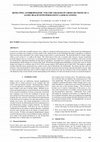
The International Archives of the Photogrammetry, Remote Sensing and Spatial Information Sciences
Coastal areas world wide are highly dynamic areas, subject to continuous deformation processes. B... more Coastal areas world wide are highly dynamic areas, subject to continuous deformation processes. Both natural and anthropogenic processes constantly cause changes at various spatial scales. Sandy beaches in the Netherlands fall under a regulation, according to which moving sand is permitted, if the volume change remains below a certain threshold. The threshold holds for volume changes within a cross section of 1 m width of the beach. The enforcement of this rule is currently labor intensive, because monitoring generally happens only on a yearly basis, or incidental and non-quantitative. Improved observation capabilities with remote sensing are advancing the supporting technology for this kind of regulations. Permanent laser scanning is a potential tool for monitoring and quantifying volume changes of a section of the beach. We develop and implement methodology to extract time series of volume change with respect to a reference date of 01-01-2020 covering January 2020 until the end of April 2020. The method is applied on point cloud data from a permanent laser scanner on the coast of Noordwijk, The Netherlands. We analyse the time series for incidents, where the threshold in volume change is passed, and find all shortest intervals during which the threshold is passed. Then we analyse potential underlying cause in order to support not only enforcement, but also evaluation of the current regulation. This will ultimately help to work towards a better understanding of the influence of small scale human activities on coastal development.
Coastal Sediments 2019, 2019
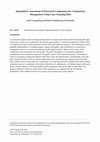
Defects in a construction site is inevitable and these defects must be inspected and reported tim... more Defects in a construction site is inevitable and these defects must be inspected and reported timely to minimize extract cost due to repair the defects. However, in practice, quality of structural elements is often inspected by a site supervisor with traditional tools (e.g. measuring tapes, total stations or levelling) at only specific locations on the structures. That results the current inspection pipeline is subjective and inefficient. As such, a new approach must develop to support project managers reporting surface defects timely and using a digital tool in project management efficiently. A great achievement of laser scanning platforms allows to acquire three-dimensional (3D) topographic data of structures' surfaces in a construction site quickly and accurately. A current terrestrial laser scanner (TLS) can capture more than a million points per second with a sub-millimetre accuracy. This technology has been gradually implemented in evaluating progress, quality and quantity...

A three-dimensional (3D) geometric model of a bridge plays an important role in inspection, asses... more A three-dimensional (3D) geometric model of a bridge plays an important role in inspection, assessment and management of the bridge. As most bridges were built after the second world war, 3D bridge models are rarely available. A recent development in laser scanning offers a cost-efficient method to capture dense, accurate 3D topographic data of the bridge. However, given the typical complexity of the bridge, a current workflow based commercial software to construct the bridge model still requires intensive labour work. This paper introduces a new approach to extract the point cloud of each surface of structural components of a slab/box beam bridge automatically in a sequential order from a superstructure to a substructure. The proposed method first employs a quadtree to decompose the point cloud of the bridge into two dimensional (2D) cells. Second, a kernel density estimation is used to separate a point cloud describing patches of surfaces within the cells. Subsequently, the cell- ...

ISPRS Journal of Photogrammetry and Remote Sensing, 2020
As more complete 3D information can be extracted from a stereo pair, using stereo images can prov... more As more complete 3D information can be extracted from a stereo pair, using stereo images can provide better changes detection from LiDAR data than using shadows in a single image. However, the quality problem of 3D information in both LiDAR data and stereo images will result in false alarms and directly affect the accurate change detection. LiDAR point clouds are sparse and irregularly spaced, and have mixed returns near building edges, while 3D information extracted from stereo images are affected by shadow and low texture. This chapter proposes LiDAR-guided edge-aware dense matching (LEAD-Matching) to address these problems explicitly for detecting accurate building changes. Data sparsity and irregular spacing is addressed by densifying LiDAR points in a form of a digital surface model (DSM). Instead of applying interpolation with associated edge problems due to mixed returns, three candidate DSMs are created by linking each DSM pixel to up to three planes as identified in segmented and triangulated LiDAR data. The candidate DSMs limit the disparity search space for dense matching, addressing low texture and shadow problems in images. Through edge-aware dense matching, the detailed building edges in stereo pairs determine the optimal heights to address LiDAR edge problem. Changes are detected where corresponding pixels from dense matching have large color differences. Due to homogeneous surroundings and shadows, only partial changes are initially detected. A second hierarchical dense matching step is employed to complete changes and update 3D information by propagating initial partial changes iteratively. The proposed method is applied on data from two cities, Amersfoort and Assen, the Netherlands, with around 1200 existing buildings. In both areas, the method successfully verifies unchanged buildings while detecting minimum changes of 2 × 2 × 2 m 3. The experiments also show that the proposed method outperforms two well-known change detection methods in terms of verifying unchanged buildings and detecting small changes simultaneously.

Remote Sensing, 2019
Many urban applications require building polygons as input. However, manual extraction from point... more Many urban applications require building polygons as input. However, manual extraction from point cloud data is time- and labor-intensive. Hough transform is a well-known procedure to extract line features. Unfortunately, current Hough-based approaches lack flexibility to effectively extract outlines from arbitrary buildings. We found that available point order information is actually never used. Using ordered building edge points allows us to present a novel ordered points–aided Hough Transform (OHT) for extracting high quality building outlines from an airborne LiDAR point cloud. First, a Hough accumulator matrix is constructed based on a voting scheme in parametric line space (θ, r). The variance of angles in each column is used to determine dominant building directions. We propose a hierarchical filtering and clustering approach to obtain accurate line based on detected hotspots and ordered points. An Ordered Point List matrix consisting of ordered building edge points enables t...

ISPRS - International Archives of the Photogrammetry, Remote Sensing and Spatial Information Sciences, 2018
Change detection is an essential step to locate the area where an old model should be updated. Wi... more Change detection is an essential step to locate the area where an old model should be updated. With high density and accuracy, LiDAR data is often used to create a 3D city model. However, updating LiDAR data at state or nation level often takes years. Very high resolution (VHR) images with high updating rate is therefore an option for change detection. This paper provides a novel and efficient approach to derive pixel-based building change detection between past LiDAR and new VHR images. The proposed approach aims notably at reducing false alarms of changes near edges. For this purpose, LiDAR data is used to supervise the process of finding stereo pairs and derive the changes directly. This paper proposes to derive three possible heights (so three DSMs) by exploiting planar segments from LiDAR data. Near edges, the up to three possible heights are transformed into discrete disparities. A optimal disparity is selected from a reasonable and computational efficient range centered on th...

Uploads
Papers by Roderik Lindenbergh